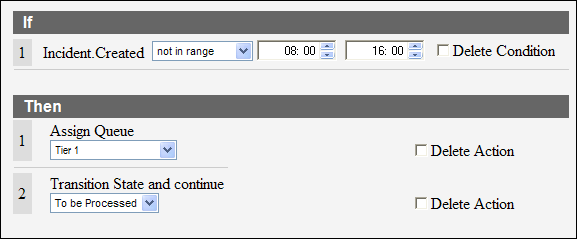Example of Routing Incidents by Time Created
You can use rules to route incidents by the time created.
For example, if a customer submits a question before or after your support staff’s normal working hours, you might want to route the incident to a backup staff member or queue who can respond to the customer. This image shows a rule that routes an incident to a Tier 1 Queue when the incident is submitted outside the normal working hours of 8:00 A.M. to 4:00 P.M.

Note: You can accomplish the same goal by using the operator In Response Interval. This
operator is used only with incident rules to indicate that the incident was added within normal
working hours. “Normal working hours” means either the response requirements of the SLA
associated with the incident or the default response requirements if no SLA is associated with
the incident.
You might not want to route every incident created outside working hours to a backup queue. Instead, you might decide to route only those that are added by certain customers. In that case, you can add another condition for the type of SLA the customer has, or for the customer’s organization.

Note: The default logical expression joins the conditions with
AND (&), meaning that both conditions must be met to
trigger the action. If the logical expression used OR (|), the action would be triggered if either one of the conditions
was met.